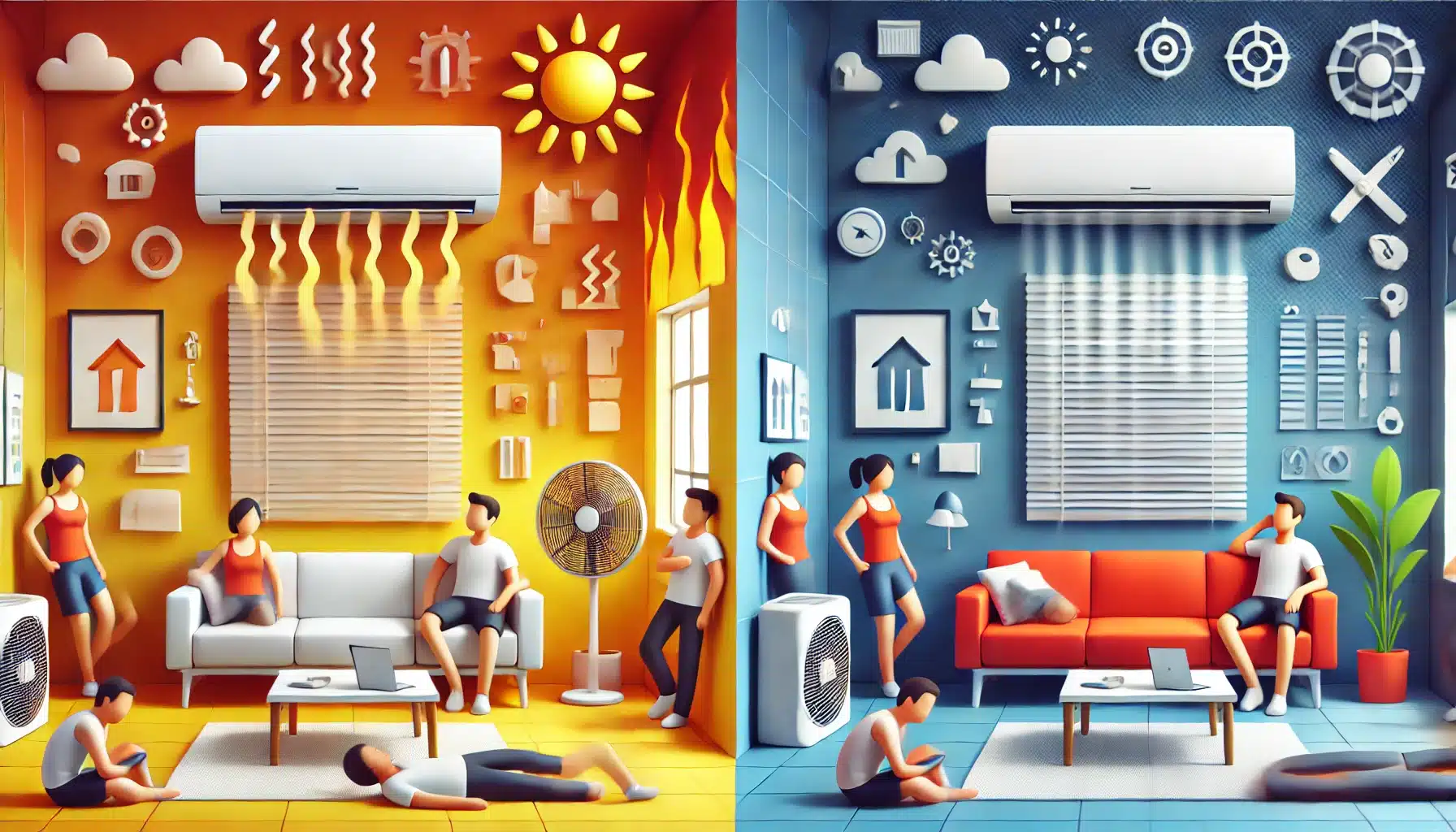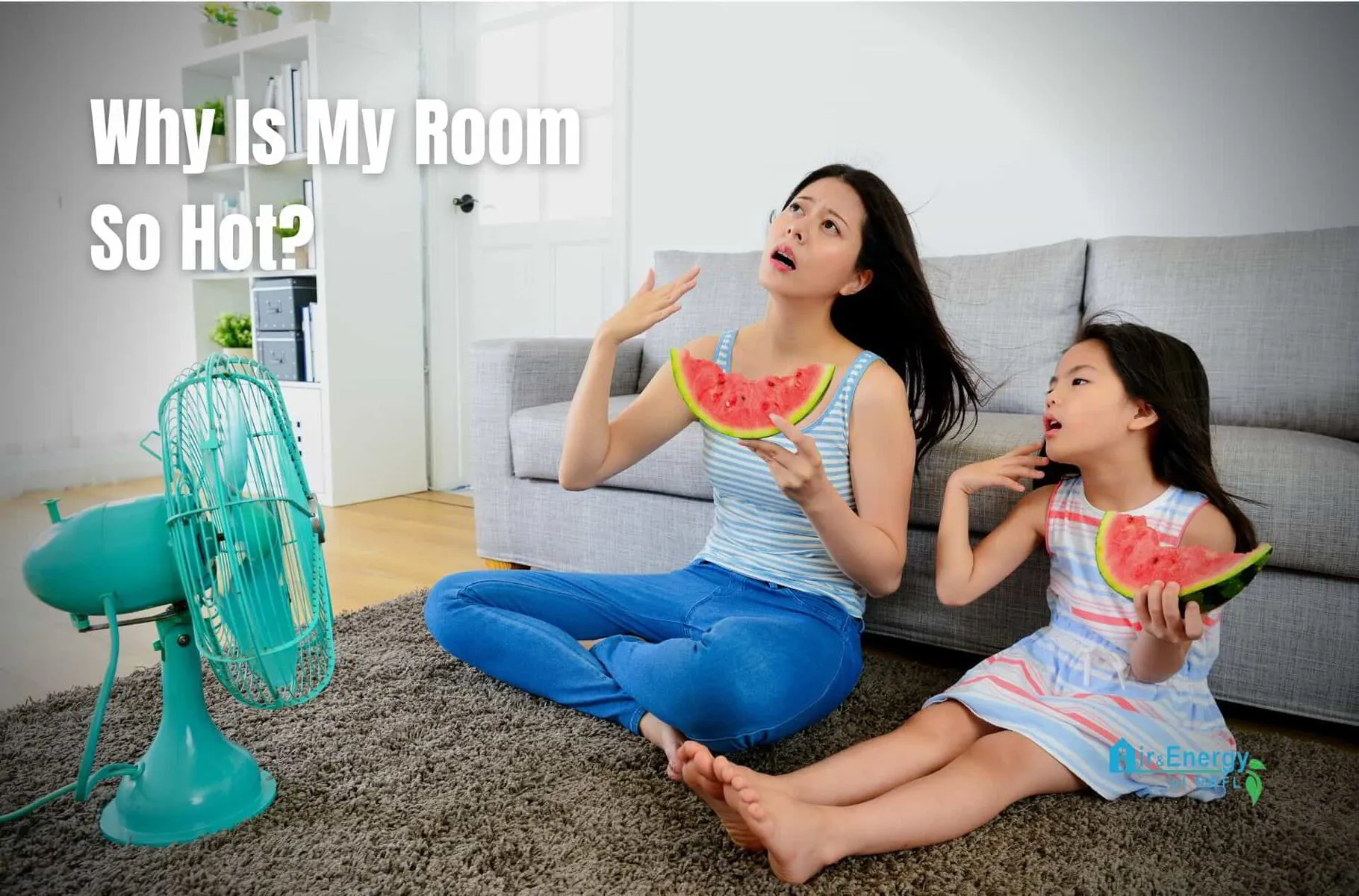Is the relentless heat in your room turning your sanctuary into a sauna? You’re not alone.
Many people face this discomfort, especially during the warmer months. But why does your room feel like a furnace when the rest of your home stays cool and comfortable? Unraveling this mystery could unlock the key to better sleep and relaxation.
Imagine stepping into your room and feeling a refreshing breeze instead of a stifling wave of heat. Intrigued? Read on to discover the hidden culprits behind your room’s scorching temperature and learn simple, effective ways to transform it into a cool haven.

Credit: alltimeairconditioning.com
Common Causes Of Overheated Rooms
Rooms become hot due to poor ventilation and direct sunlight. Old air conditioning systems struggle to cool efficiently. Heat from electronics and lighting can also raise temperatures significantly.
If you’ve ever wondered why your room feels like a sauna, you’re not alone. Many people struggle with overheated rooms, especially during the warmer months. Understanding the root causes can help you take the right steps to cool down your living space. Let’s dive into some common causes of overheated rooms.
Poor Ventilation
One major culprit of hot rooms is poor ventilation. Without proper airflow, warm air gets trapped, making your space feel stuffy. Have you checked if your air vents are blocked by furniture or dust? Often, simply rearranging furniture or cleaning vents can make a noticeable difference.
Insufficient Insulation
Another common issue is insufficient insulation. Is your room losing cool air faster than it can produce it? Improper insulation can let the heat in and the cool air out. Adding weather stripping to windows or using thermal curtains can help maintain a comfortable temperature.
Heat-producing Electronics
Electronics like computers, TVs, and lamps can generate a surprising amount of heat. Do you often leave your devices on when not in use? Switching off electronics when they’re not needed can reduce the heat load in your room. Consider using energy-efficient LED bulbs to cut down on additional heat.
Sunlight Exposure
Rooms that are exposed to direct sunlight can turn into mini greenhouses. Does your room get a lot of sun during the day? Using blackout curtains or reflective window film can help block out the sun’s rays. Also, think about moving your bed or seating area away from sunlit areas to stay cooler. Identifying these common causes can empower you to make small, yet effective changes. What steps will you take to cool down your room today?

Credit: sansone-ac.com
Assessing Your Room’s Heat Sources
Feeling like you’re living in a sauna? Your room’s heat sources might be the reason. Understanding these contributors can help cool down your space. Let’s delve into the factors turning your room into a hot zone.
Identifying Electronic Heat Contributors
Electronics generate heat. Computers, televisions, and chargers are prime culprits. Even small devices contribute to the heat. Check what electronics are running constantly. Turn off unused devices to reduce heat output.
Evaluating Sunlight And Window Efficiency
Sunlight can be a major heat source. Windows facing direct sunlight increase room temperature. Assess window efficiency. Consider curtains or shades to block excessive sun. Inspect for cracks or gaps letting heat in.
Checking Ventilation And Airflow
Ventilation impacts room temperature. Poor airflow traps heat. Check vents for blockages. Ensure air conditioners or fans are working properly. Open windows or doors to increase airflow, cooling the room.
Improving Room Ventilation
Feeling like your room is a sauna? Improving ventilation can help. Proper airflow is key to reducing heat and creating a cooler environment. Let’s explore some practical ways to enhance your room’s ventilation.
Using Fans Effectively
Fans circulate air efficiently. They push hot air out and bring cool air in. Position your fan near a window or door for best results. This allows fresh air to enter and stale air to exit. Ceiling fans also help. They move air around the room and make it feel cooler. Keep them running on hot days.
Installing Ventilation Systems
Consider installing a ventilation system. These systems are designed to remove heat and moisture. They provide a continuous flow of fresh air. Look for options like exhaust fans or air vents. These can be added to walls or ceilings. They help maintain a comfortable temperature by improving airflow.
Opening Windows Strategically
Windows are natural ventilators. Open them during cooler hours. Morning and evening are ideal times. This lets in fresh air and reduces heat buildup. Close them when the sun is strong. This prevents hot air from entering. Use window shades or blinds to block direct sunlight.
Enhancing Insulation And Window Treatments
Is your room unbearably hot, even when the AC is running? The problem might not be your air conditioning but rather the insulation and window treatments in your space. Enhancing these elements can significantly impact your room’s temperature, making it more comfortable all year round. Let’s dive into some simple yet effective strategies to help cool things down.
Choosing Energy-efficient Curtains
Energy-efficient curtains can be a game-changer for your room’s temperature. They help block out the heat during the summer months and retain warmth during the winter. Have you ever noticed how sunlight streaming through your windows can turn your room into a sauna? Choosing curtains with thermal lining can reduce this effect dramatically.
Look for curtains labeled as “insulated” or “thermal”. These curtains often have thicker fabric designed to prevent heat transfer. Opt for darker colors if you’re aiming to block more sunlight. You might be surprised at the difference a simple curtain swap can make.
Sealing Gaps And Cracks
Even the smallest gaps around windows and doors can let in heat. Think of it as your room silently screaming for help! Sealing these gaps can be a straightforward DIY project that saves you from sweating through the night.
Use weather stripping or caulk to seal any cracks around window frames. Ensure that your door sweeps are intact. If you can see light coming through the edges of your doors or windows, it’s time to seal them up. This simple fix can greatly reduce unwanted heat entry.
Installing Window Films
Window films are another efficient method to control heat in your room. These films are like sunglasses for your windows, reducing glare and blocking out UV rays. Have you ever thought about how much heat your windows let in?
Installing window films can decrease the amount of solar heat entering your room. They are available in different shades and levels of UV protection. Application is generally easy, and many films are designed for DIY installation. This small investment can keep your room cooler without sacrificing natural light.
By enhancing your room’s insulation and window treatments, you can take control of your indoor climate. Which of these solutions will you try first to keep your room at a comfortable temperature?
Cooling Technologies And Devices
Is your room feeling like a sauna? Let’s dive into some cooling technologies and devices that can help you reclaim your comfort. Whether you’re battling the summer heat or dealing with stuffy indoor air, there are practical solutions to keep your space cool and pleasant. From traditional air conditioners to smart thermostats, there’s a cooling device for every need and budget.
Air Conditioners
Air conditioners are a classic choice for cooling rooms, offering powerful and reliable temperature control. They work by removing heat from the air and circulating cool air throughout your space. You can choose from window units, portable models, or central systems based on your room size and budget.
Think about how often you use your air conditioner and its energy efficiency. Choosing an energy-efficient model can save on electricity bills. A good tip is to clean or replace filters regularly to keep the unit running smoothly.
Evaporative Coolers
If you’re searching for an eco-friendly option, consider evaporative coolers, often known as swamp coolers. These devices use water and fans to cool the air, making them ideal for dry climates. They consume less energy compared to traditional air conditioners, reducing your carbon footprint.
However, they work best in low-humidity environments. If your area is humid, they might not be as effective. Always check the humidity levels in your region before opting for an evaporative cooler.
Smart Thermostats
Smart thermostats are game-changers for managing your room’s temperature. They learn your preferences and adjust settings automatically, providing comfort while saving energy. These devices can be controlled via smartphone apps, allowing you to set the perfect temperature even when you’re away.
Have you considered integrating a smart thermostat with your existing cooling system? It can optimize your energy usage and lower utility costs. Plus, they often come with features like energy usage reports, helping you make informed decisions about your cooling habits.
Which cooling technology seems right for your room? Each option has its advantages, and understanding your specific needs will guide you to the best choice. Whether you prioritize energy efficiency, environmental impact, or convenience, there’s a solution waiting for you.
Alternative Cooling Techniques
Is your room feeling like a sauna even with the AC running? You’re not alone. Many people struggle to keep their spaces cool without blasting the air conditioning all day. Luckily, there are alternative cooling techniques that can help lower the temperature and save energy. Whether it’s using houseplants or rethinking when you open your windows, these methods can make a significant difference.
Using Houseplants For Cooling
Did you know that certain houseplants can help cool your room? Plants like ferns and rubber plants can act as natural air conditioners. They release moisture into the air, which can help lower the temperature slightly.
Plus, they absorb carbon dioxide and release oxygen, improving air quality. Just make sure to water them regularly. A friend once mentioned that her room felt cooler after she filled it with houseplants. Try adding a few leafy greens and see if you notice a change.
Adopting Nighttime Cooling Strategies
Your windows are crucial in controlling room temperature. Open them at night when the air is cooler. This allows fresh air to circulate, lowering indoor temperatures. It’s surprising how much a breeze can help.
In the morning, close windows and curtains to trap the cool air inside. This simple method can keep your room comfortable throughout the day. Have you ever felt the difference a cool night breeze can make?
Reducing Electronic Heat Output
Electronics can be sneaky heat sources. Devices like laptops and TVs generate warmth that can make your room feel hotter. Turn off electronics when they’re not in use to minimize heat output.
Consider placing them away from areas where you spend the most time. A friend once moved her charging station to a different room and noticed a cooler environment. Every little bit helps when it comes to cooling down.
Energy-efficient Cooling Practices
Feeling hot in your room can be frustrating. Poor insulation and blocked vents often trap heat. Energy-efficient cooling practices, like using fans and keeping blinds closed, can help maintain a comfortable temperature.
When the sweltering summer heat turns your room into an oven, you might be left wondering if there’s a way to cool things down without cranking up the air conditioning bill. Energy-efficient cooling practices can be your saving grace. By tweaking how you cool your room, you can enjoy a comfortable space while keeping energy use in check. Here are some practical tips to help you get started.
Optimizing Cooling Settings
Fine-tuning your cooling settings can make a significant difference. Try setting your air conditioner to a comfortable temperature rather than the lowest possible. You’d be surprised how a slight adjustment can save energy. Consider using a programmable thermostat if you have one. Program it to raise the temperature when you’re not home and cool things down before you return. This ensures comfort without wasting energy. Use fans strategically. Ceiling fans can work wonders when paired with air conditioning. They circulate cool air, allowing you to set the AC a few degrees higher without sacrificing comfort.
Regular Maintenance Of Cooling Devices
Regular maintenance is crucial for keeping your cooling devices running efficiently. Clean or replace air filters every month during high-use periods. A clean filter ensures proper airflow and reduces the workload on your system. Inspect your air conditioner’s evaporator coil annually. Dust and dirt can diminish its ability to absorb heat, so keeping it clean is essential for optimal performance. Don’t forget about your fans. Dust can accumulate on blades, reducing their effectiveness. A quick clean can keep them spinning smoothly and efficiently.
Energy-saving Tips
Simple habits can lead to significant energy savings. Close blinds or curtains during the hottest parts of the day to block out the sun’s heat. This keeps your room cooler and reduces the need for extra cooling. Consider investing in energy-efficient windows or adding window film. These can reflect heat away from your home, making your cooling efforts more effective. Think about your lighting. Incandescent bulbs emit heat, so switching to LED lights can reduce room temperature slightly while saving energy. Is there a way you can make use of natural ventilation? Opening windows in the evening when temperatures drop can help cool your room naturally. It’s a simple way to refresh your space without using electricity. By adopting these energy-efficient cooling practices, you can transform your hot room into a comfortable oasis without spiking your energy bill. What small change will you try first?

Credit: airandenergynwfl.com
Frequently Asked Questions
Why Is My Room Hotter Than The Rest Of The House?
Your room may have poor insulation. Or direct sunlight. Check for drafts and adjust the thermostat.
How Can I Cool Down My Hot Room?
Use a fan or air conditioner. Close curtains to block sunlight. Improve ventilation with open windows.
Does Room Color Affect Temperature?
Yes, dark colors absorb heat. Light colors reflect it. Consider repainting for a cooler room.
Why Does My Room Feel Stuffy And Hot?
Poor air circulation can cause stuffiness. Use a fan or open windows for fresh air.
Can Electronics Make My Room Hotter?
Yes, electronics emit heat. Turn off unused devices. Consider unplugging chargers to reduce heat.
Conclusion
Your room’s heat problem has many possible causes. Check insulation first. Poor insulation traps heat inside. Look at window coverings. Thick curtains block sun rays effectively. Consider electronic devices. They generate heat when running. Ventilation matters too. Ensure air can circulate freely.
Fans can help move air around. These simple steps can make a big difference. Improving comfort is possible. Stay cool and enjoy your space. Address these issues for a cooler room. Your comfort matters. Small changes lead to big relief.
Stay proactive with room temperature control.




